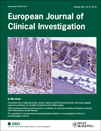Cyclosporine metabolic side effects: association with the WNK4 system
Abstract
Eur J Clin Invest 2011; 41 (10): 1113–1120
Background Cyclosporine is used for treatment of transplanted patients and for immune-mediated diseases. Cyclosporine is known to cause a combination of metabolic side effects including hypertension, hyperkalemia, hypercalciuria and hypomagnesemia. These side effects except for hypomagnesemia are the cardinal features of familial hyperkalemia and hypertension (FHHt), also called pseudohypoaldosteronism type II (PHA II). FHHt is caused by mutations in the kinases WNK1 and WNK4 resulting in an increase in renal Na-Cl cotransporter (NCC) apical distribution and function. Therefore, we studied whether cyclosporine’s metabolic side effects are mediated by WNK4 and NCC.
Design Sprague-Dawley (SD) rats were treated by cyclosporine 25 mg kg−1 subcutaneously for 14 days. Blood pressure, blood chemistry values and kidney WNK4 protein were determined. In addition, mDCT cells were exposed to cyclosporine, and their WNK4 mRNA and protein content, and their NCC protein content and phosphorylation were determined.
Results The rats developed an FHHt-like syndrome including hypertension, hyperkalemia and salt-sensitive hypercalciuria. A significant increase in their kidney WNK4 protein content (0·13 ± 0·01 vs. 0·67 ± 0·16 WNK4/GAPDH in controls, P = 0·0183) was found. In mDCT cells, cyclosporine caused a rise in WNK4 mRNA levels and also a threefold rise in WNK4 protein content. This rise was followed by a rise in NCC protein content and pSer71 phosphorylation.
Conclusions These observations may explain in part the mechanism of cyclosporine-induced hypertension, hyperkalemia and hypercalciuria.




